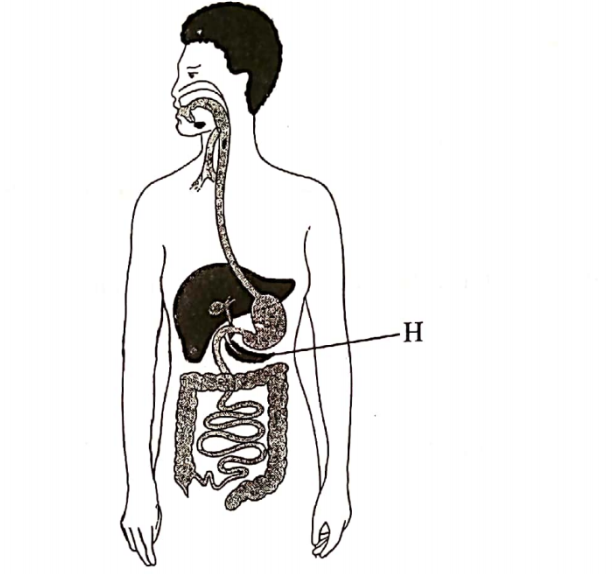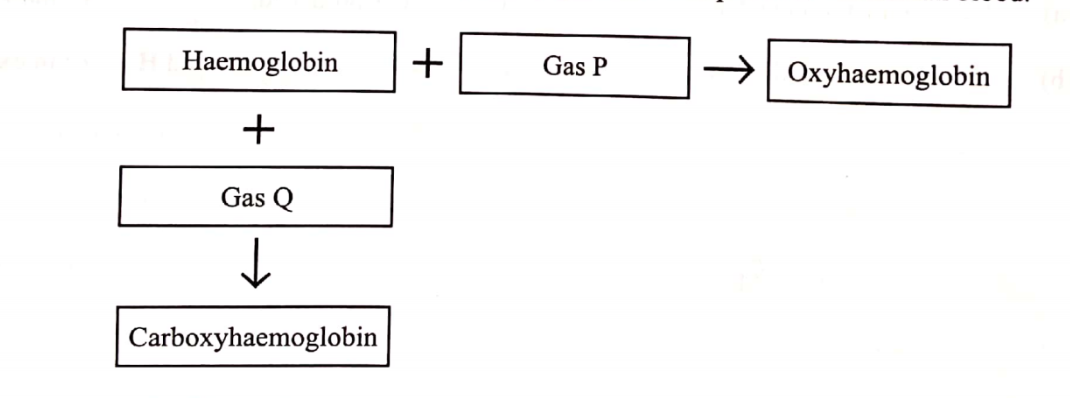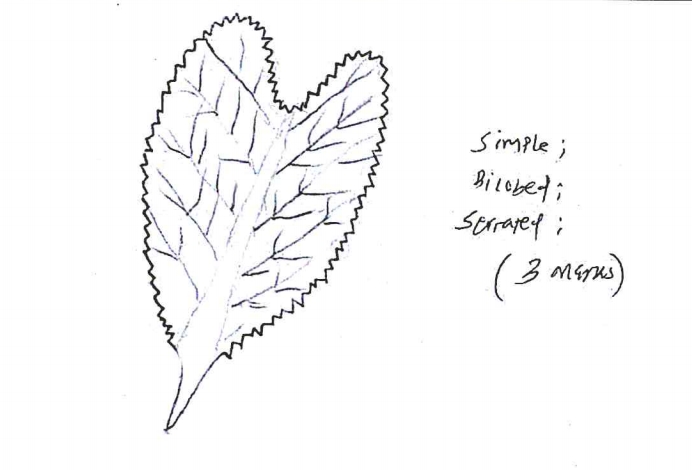2019 KCSE Biology Paper 1 Past Paper
Answer all the questions in the spaces provided.
1. Name the characteristic of living organisms illustrated by each of the activities described below: (a) Dressing heavily (1 mark)
(b) Bursting of the sporangium in the Rhizopus sp (1 mark)
2. (a) Besides venation, state two other external characteristics of leaves that can be used to classify plants.(2 marks)
(b) Explain why the bat is classified as a mammal yet it flies.(2 marks)
3. The diagram below illustrates a specialised cell obtained from a certain tissue.

(a) Name the cell.(2 marks)
(b) State two ways in which the cell is structurally adapted to its function. (2 marks)
4. In investigating a certain pliysiological process, students set up the apparatus as shown below and made the observation after 30 minutes as illustrated.

(a) Name the physiological process being investigated.(1 mark)
………………………………
(b) Account for the observation made at the end of the experiment.(3 mark)
……………………………………………….. …
………………………..
(c) State the likely identity of G.(3 mark)
———————————————————
5. Explain why significantly increasing the blood pH slows down the rate of selective reabsorption of materials in the kidney tubules. (3 marks)
————————————————
————————————————–
6. (a) Name the respiratory structure in the amoeba.(1 mark)
——————————-
(b) Give a reason for your answer in (a) above.(1 mark)
….. …… ………………………
7. Distinguish between chemical and mechanical digestion.(1 mark)
———————————————-
——————————————-
g. State the role of each of the following in the mammalian respiratory system:
(a) mucus (2 marks)
——————————————————————————
————————————————————————
(b) cartilage rings (1 mark)
——————————————————————————
————————————————————————
(c) epiglottis (1 mark)
——————————————————————————
————————————————————————
9. Below is a photograph of Brassica oleracea, Sukuma wiki leaf.

(a) State two observable features that adapt the leaf to gaseous exchange. (2 marks)
——————————————————————————–
———————————————————————————
(b) State two observable features that adapt the leaf to gaseous exchange.(2 marks)
——————————————————————————–
———————————————————————————
10. In an investigation, students set up the apparatus below in the laboratory and made observations after 72 hours.

(a) Explain how inclusion of the following components would affect the mouse in the experiment:
(i) light (2 marks)
———————————————————————-
——————————————————————-
(ii) sodium hydroxide solution (2 marks)
————————————————————————
—————————————————————————
11. Explain each of the following physiological observation :
(A) Sportsmen release little, concentratcd urine at the end Of a strenuous exercise (3 marks)
—————————————–
——————————————-
———————————————
(b) A rabbit has a higher oxygen demand than a camel (3 marks) ——————————————————————————
——————————————————————————
12. While investigating a certain metabolic process in plants, students set up the apparatus as shown below in a classroom and monitored it for 48 hours.

(a) Identify the metabolic process under investigation.(1 mark)
————————————————
(b) Account for the observations made in the test tube at the end of the investigation. (2 Marks)
————————————–
——————————————
13. A female human being was found to have an extra sex chromosome in her cells.
(a) Give the total number of chromosomes in the female individual’s cells.(1 Marks)
—————————
(b) Explain the possible cause of this condition.(2 Marks)
————————————-
——————————-
(c) State two physical characteristics observed in the female individual with such a condition. ———————————
14. (a) Explain why fossil records as evidence of organic evolution are usually incomplete.(3 marks) ———————————————-
—————————————————
(b) Name the evidence of organic evolution exhibited by occurrence of similar amino acid molecules in a range of organisms. (1 Marks)
—————————————
15. (a) Distinguish between guttation and transpiration.(1 Marks)
————————————
—————————
(b) State the significance of transpiration to a plant.(2 Marks)
—————————–
——————————-
16. State two benefits of mutation in living organisms. (2 Marks)
——————————————-
—————————————-
17. Below are photographs of two dogs.

Explain the possible reason for the difference in the length of their fur. (2 marks)
18. Name the type of teeth in carnivores mainly used for piercing and killing of preys. (1 mark)
19. Below is a diagram of the human digestive system.

(a) Label with Y on the diagram where enzyme amylase is produced. (2 marks)
(b) Besides the digestive role, explain one other function of the part labelled H. (2 marks)
——————————–
…………………………….
20. State how each of the following features enhance efficient movement of fish in water.
(a) Scale (1 mark)
(b) body shape (1 mark)
21. Make a diagram of a simple, bilobed leaf with a serrated margin.(3 marks)
22. The chart below illustrates how respiratory gases are transported in the human blood.

(a) Identify gas Q. (1 mark)
(b) Explain the advantage oxyhaemoglobin has over carboxyhaemoglobin.(2 marks)
23. State three homeostatic roles of the liver. (3 marks)
24. (a) Plasmodium vivax and P lasmodium ovale are transmitted by a mosquito. State with a reason whether the tWo organism s can interbreed. (2 marks)
(b) Explain the evolutionary basis for the ever changing drugs for malaria treatment. (2 marks)
25. State one characteristic of muscles responsible for each of the following:
(a) peristaltic movement (1 marks)
(b) movement of limbs (1 marks)
2019 KCSE Biology Paper 1 Past Paper-Marking Scheme/Answers
1. Name the characteristic of living organisms illustrated by each of the activities described below:
(a) Dressing heavily (1 mark)Irritability/sensitivity/Response to a stimulus/stimuli
(b) Bursting of the sporangium in the Rhizopus sp (1 mark)Reproduction
2. (a) Besides venation, state two other external characteristics of leaves that can be used to classify plants.(2 marks)Shape of the leaf/lamina (broad/narrow); (Leaf) margin (smooth/serrated/lobed); (Leaf) type (simple/compound); (Leaf) sheath/petiole(absence/presence) (Leaf) apex (pointed/absent); Arrangement/phyllotaxis/phyllotaxy; (Leaf) colour/variegation
(b) Explain why the bat is classified as a mammal yet it flies.(2 marks)
• Has mammary glands;
• Body covered by fur/hair;
• Gives birth/does not lay eggs/is viviparous;
• Has external ears/pinna;
• Has sweat glands;
3. The diagram below illustrates a specialised cell obtained from a certain tissue.

(a) Name the cell.(2 marks)Nerve cell/motor neurone
(b) State two ways in which the cell is structurally adapted to its function. (2 marks)
• Longer axon to deliver/transmit action potential a long way;
• Has (numerous) dendrites for receiving/delivering impulses/transmit impulses;
• Myelin sheath for faster transmission of impulses;
• Schwann cell for secretion of myelin sheath;
• Nodes of ranvier to enhance speed of transfer of impulses;
• Cell body to control transmission of impulses;
4. In investigating a certain pliysiological process, students set up the apparatus as shown below and made the observation after 30 minutes as illustrated.

(a) Name the physiological process being investigated.(1 mark)Osmosis
(b) Account for the observation made at the end of the experiment.(3 mark)Solution E was hypertonic/had more solute molecules compared to solution F/solution F was hypotonic to solution E by osmosis, water molecules moved through the semi-permeable membrane, G (from solution F to E); hence the decrease in volume of solution F/increased volume of solution E
(c) State the likely identity of G.(3 mark)
Semi-permeable membrane/visking tubing/slice of a raw potato/ pawpaw/pig bladder/cellophane paper/dialysis membrane;
5. Explain why significantly increasing the blood pH slows down the rate of selective reabsorption of materials in the kidney tubules. (3 marks)Selective reabsorption of materials in the kidney tubules is energy-dependent/requires energy; synthesized through the process of cellular respiration/action of respiratory enzymes; whose working (effectiveness) is affected by changes in pH/are denatured at low pH/high acidity;/pH affects the working/permeability of the (kidney tubule cell) membranes; OWTTE
6. (a) Name the respiratory structure in the amoeba.(1 mark)Cell/plasma membrane/plasmalemma
(b) Give a reason for your answer in (a) above.(1 mark)(Amoeba) is a unicellular living organism hence has a large surface area to volume ratio, diffusion (across its cell membrane) is adequate for its respiratory needs/does not require an elaborate respiratory system;
7. Distinguish between chemical and mechanical digestion.(1 mark)Chemical digestion entails the action on/break-down of (ingested) food materials (in the alimentary canal) by the action of digestive enzymes (and converted into forms that can be easily absorbed or assimilated into the body system) while mechanical digestion refers to the physical breakdown of (larger) food materials (into smaller forms/pieces) which can subsequently be acted upon by the digestive enzymes;
g. State the role of each of the following in the mammalian respiratory system:
(a) mucus (2 marks)
Mucus — traps foreign particles from the inhaled/incoming air; — Moistens the (in-coming/inhaled) air (for efficient gaseous exchange)
(b) cartilage rings (1 mark)Cartilage rings — keep the wind pipe/trachea open/not to collapse (to allow for continuous flow of air);
(c) epiglottis (1 mark)
Epiglottis — acts as a valve/flap between the larynx and the oesophagus to permit air to enter the air-way to the lungs and food particles to pass into the gut;
9. Below is a photograph of Brassica oleracea, Sukuma wiki leaf.

(a) State two observable features that adapt the leaf to gaseous exchange. (2 marks)Broad leaf blade/lamina; that exposes more stomata for gaseous exchange/provide large surface area for gaseous exchange
(b) Explain the relationship between photosynthesis and aerobic respiration within the leaf Photosynthesis (within the leaf occurs in the presence of light energy) yielding simple carbohydrates/glucose/sugars which form the main substrates during aerobic respiration, producing energy/ATP; during the process (of respiration), carbon (IV) oxide produced is in turn used as a raw material in photosynthesis; during which process/stage, water is broken down, yielding oxygen; which is used in cellular (aerobic)
10. In an investigation, students set up the apparatus below in the laboratory and made observations after 72 hours.

(a) Explain how inclusion of the following components would affect the mouse in the experiment:
(i) light (2 marks)Light enables the potted plant to photosynthesize; producing oxygen which is inhaled by the mouse, sustaining it; the illuminated light can further affect/alter some physiological processes in the mouse as a result of the constant, direct beam of lightObsorbs carbon (IV) oxide (mainly) exhaled by the mouse; while at the same time denying the plant the needed raw material, carbon (IV) oxide, to photosynthesize, hence suffocating the mouse/limiting its survival
(ii) sodium hydroxide solution (2 marks) Bell jar is transparent, allows penetration of light for the plant to photosynthesize; tin box is opaque, could easily heat up, altering the temperature inside for the mouse/plant
11. Explain each of the following physiological observation :
(A) Sportsmen release little, concentrated urine at the end Of a strenuous exercise (3 marks)
During/after the exercises, one sweats (profusely, to cool the body/ eliminate some nitrogenous wastes); a lot of water is lost through this/ one is dehydrated; the little water that is left in the body system is further (selectively) reabsorbed in the kidney tubules; resulting in less, concentrated urine.
(b) A rabbit has a higher oxygen demand than a camel (3 marks)A rabbit has a higher surface area to volume ratio; hence has a bigger surface exposed for heat loss to the environment; it is also more active than the camel hence need more oxygen to (aerobically) respire to synthesize the needed energy to support its active lifestyle.
12. While investigating a certain metabolic process in plants, students set up the apparatus as shown below in a classroom and monitored it for 48 hours.

(a) Identify the metabolic process under investigation.(1 mark)Respiration (aerobic/anaerobic)
(b) Account for the observations made in the test tube at the end of the investigation. (2 Marks)The lime water/calcium hydroxide solution in the test tube formed a white precipitate/ turned milky turbid; plants respire, producing carbon (IV) oxide (which forms a white precipitate with lime water)
13. A female human being was found to have an extra sex chromosome in her cells.
(a) Give the total number of chromosomes in the female individual’s cells.(1 Marks)47 chromosomes
(b) Explain the possible cause of this condition.(2 Marks)Non-disjunction/ failure of homologous chromosomes to separate/ segregate/sister chromatids fail to separate/segregate; resulting in having an extra sex chromosome (X-chromosome) in a cell/having (XXX) instead of (XX) OWITTE
(c) State two physical characteristics observed in the female individual with such a condition.
• Infertile/ovary abnormalities;
• Taller than the average female;
• Developmental delays;
• Higher voice pitch;
• (More pronounced) signs of obesity
14. (a) Explain why fossil records as evidence of organic evolution are usually incomplete.(3 marks)
•Partial/entire decomposition of dead organisms/organic matter/ fossils;
• Some parts of or entire dead organisms are eaten by scavengers
• Soft-bodied organisms do not fossilize;
• Natural disasters, like earthquakes/earth movements
(b) Name the evidence of organic evolution exhibited by occurrence of similar amino acid molecules in a range of organisms. (1 Marks)Comparative physiology/biochemistry/cell biology/serology;
15. (a) Distinguish between guttation and transpiration.(1 Marks)
•Enables the plant to get rid of excess water;
• Creates a suction force/helps in the uptake of water/mineral salts from the soil;
• Cools the plant;
(b) State the significance of transpiration to a plant.(2 Marks)
• Enables the plant to get rid of excess water;
• Creates a suction force/helps in the uptake of water/mineral salts from the soil;
• Cools the plant
16. State two benefits of mutation in living organisms. (2 Marks)
• Can bring about beneficial/advantageous traits;
• Increases heterozygosity (and size of gene pool)/increase variation
17. Below are photographs of two dogs.

Explain the possible reason for the difference in the length of their fur. (2 marks)
• Geographical distribution; made the animals adapt to survive in different environments (cold/hot), with those having thicker fur being adapted to colder regions (for insulation);
• Genetic/being passed on from the parents to the offspring
18. Name the type of teeth in carnivores mainly used for piercing and killing of preys. (1 mark)Canine
19. Below is a diagram of the human digestive system.

(a) Label with Y on the diagram where enzyme amylase is produced. (2 marks)
• Salivary glands (in the mouth);
• Pancrease;
(b) Besides the digestive role, explain one other function of the part labelled H. (2 marks)Endocrine (function); secretes (insulin and glucagon) hormones; responsible for blood sugar regulation/osmoregulation; OWTTE
20. State how each of the following features enhance efficient movement of fish in water.
(a) Scale (1 mark)Scales — Taper/overlapping/facing backwards to provide a smooth surface for easier movement/are slimy/covered with mucous for easier/ smooth movement in water /reduce friction/resistance;
(b) body shape (1 mark)Body shape — streamlined body shape to reduce friction/pointed (stiff) head for easier penetration/movement in water.
21. Make a diagram of a simple, bilobed leaf with a serrated margin.(3 marks)

22. The chart below illustrates how respiratory gases are transported in the human blood.

(a) Identify gas Q. (1 mark)Carbon(ll)Oxide/CO
(b) Explain the advantage oxyhaemoglobin has over carboxyhaemoglobin.(2 marks)Oxyhaemoglobin is unstable/freely dissociates, releasing oxygen to the tissues/dissociates leaving haemoglobin molecules free to take up more gaseous molecules; (hence constantly supplying the much needed oxygen to the respiring tissues) Carboxyhaemoglobin is stable/binds itself/holds on the haemoglobin molecules/does not dissociate, hence starving the tissues/cells of the oxygen, leading to suffocation/death; OWTTE
23. State three homeostatic roles of the liver.(3 marks)
•Thermoregulation/temperature regulation;
• Blood sugar balance;
• Protein/amino acid/fat regulation;
24. (a) Plasmodium vivax and Plasmodium ovale are transmitted by a mosquito. State with a reason whether the two organisms can interbreed. (2 marks)They can interbreed; because they belong to the same genus (though they belong to different species);
(b) Explain the evolutionary basis for the ever changing drugs for malaria treatment. (2 marks) The malaria-causing parasites over time, become resistant to some malarial drugs; due to gradually changing their genetic constitution (because of mutation) which, with time, results in the evolution and eventual perpetuation of the new strains of vectors, hence necessitating the discovery of a more effective drug to counter the new/emerging strains; OWTTE
25. State one characteristic of muscles responsible for each of the following:
(a) peristaltic movement (1 marks)
• Spindle shaped;
• Lack striations/not striated;
• Uninucleated/one nucleus;
(b) movement of limbs (1 marks)
• Striated;
• Cylindrical shaped;
• Numerous mitochondria;
• Multinucleated

